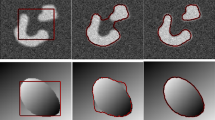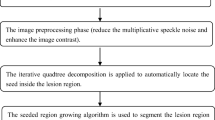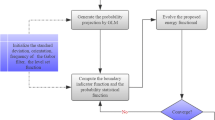Abstract
In this paper, a novel lesion segmentation within breast ultrasound (BUS) image based on the cellular automata principle is proposed. Its energy transition function is formulated based on global image information difference and local image information difference using different energy transfer strategies. First, an energy decrease strategy is used for modeling the spatial relation information of pixels. For modeling global image information difference, a seed information comparison function is developed using an energy preserve strategy. Then, a texture information comparison function is proposed for considering local image difference in different regions, which is helpful for handling blurry boundaries. Moreover, two neighborhood systems (von Neumann and Moore neighborhood systems) are integrated as the evolution environment, and a similarity-based criterion is used for suppressing noise and reducing computation complexity. The proposed method was applied to 205 clinical BUS images for studying its characteristic and functionality, and several overlapping area error metrics and statistical evaluation methods are utilized for evaluating its performance. The experimental results demonstrate that the proposed method can handle BUS images with blurry boundaries and low contrast well and can segment breast lesions accurately and effectively.









Similar content being viewed by others
References
Jemal A, Siegel R, Ward E, Hao Y, Xu J, Murray T: Cancer statistics, 2008. Cancer J Clin 58:71–96, 2008
Cheng HD, Shi X, Min R, Hu L, Cai X, Du H: Approaches for automated detection and classification of masses in mammograms. Pattern Recognition 39(4):646–668, 2006
Cheng HD, Shan J, Ju W, Guo YH, Zhang L: Automated breast cancer detection and classification using ultrasound images: a survey. Pattern Recognition 43:299–317, 2010
Cheng HD, Jiang XH, Sun Y, Wang JL: Color image segmentation: advances and prospects. Pattern Recognition 34(12):2259–2281, 2001
Horsch K, Giger ML, Venta LA, Vyborny CJ: Computerized diagnosis of breast lesions on ultrasound. Med Phys 29(2):157–164, 2002
Drukker K, Giger ML, Horsch K, Kupinski MA, Vyborny CJ, Mendelson EB: Computerized lesion detection on breast ultrasound. Med Phy 29(7):1438–1446, 2002
Madabhushi A, Metaxas DN: Combining low–high-level and empirical domain knowledge for automated segmentation of ultrasonic breast lesions. IEEE Trans Med Imag 22(2):155–169, 2003
Boukerroui D, Baskurt A, Noble JA, Basset O: Segmentation of ultrasound images—multiresolution 2D and 3D algorithm based on global and local statistics. Pattern Recogn Lett 24:779–790, 2003
Xiao GF, Brady M, Noble JA, Zhang YY: Segmentation of ultrasound B-mode images with intensity inhomogeneity correction. IEEE Trans Med Imag 21(1):48–57, 2002
Cheng HD, Hu L, Tian J, Sun L: A novel Markov random field segmentation algorithm and its application to breast ultrasound image analysis. The 6th International Conference on Computer Vision, Pattern Recognition and Image Processing, Salt Lake City, USA, p 159, 2005
Chen DR, Chang RF, Wu WJ, Moon WK, Wu WL: 3-D breast ultrasound segmentation using active contour model. Ultrasound Med Biol 29(7):1017–1026, 2003
Chang RF, Wu WJ, Moon WK, Chen WM, Lee W, Chen DR: Segmentation of breast tumor in three-dimensional ultrasound images using three-dimensional discrete active contour model. Ultrasound Med Biol 29(11):1571–1581, 2003
Chen DR, Chang RF, Kuo WJ, Chen MC, Huang YL: Diagnosis of breast tumors with sonographic texture analysis using wavelet transform and neural networks. Ultrasound Med Biol 28(10):1301–1310, 2002
Huang YL, Chen DR: Watershed segmentation for breast tumor in 2-D sonography. Ultrasound Med Biol 30:625–632, 2004
Chen CM, Chou YH, Chen CSK: Cell-competition: a new segmentation algorithm for multiple objects with irregular boundaries in ultrasound images. Ultrasound Med Biol 31(12):1647–1664, 2005
Chang RF, Wu WJ, Moon WK, Chen DR: Automatic ultrasound segmentation and morphology based diagnosis of solid breast tumors. Breast Cancer Res Treat 89(2):179–185, 2005
Liu B, Cheng HD, Huang JH, Tian JW, Liu JF, Tang XL: Automated segmentation of ultrasonic breast lesions using statistical texture classification and active contour based on probability distance. Ultrasound Med Biol 35(8):1309–1324, 2009
Liu B, Cheng HD, Huang JH, Tian JW, Tang XL, Liu JF: Probability density difference-based active contour for ultrasound image segmentation. Pattern Recognition 43:2028–2042, 2010
Chen Y, Yin RM, Flynn R, Broschat S: Aggressive region growing for speckle reduction in ultrasound images. Pattern Recognition lett 24:677–691, 2003
Michailovich OV, Tannenbaum A: Despeckling of medical ultrasound images. IEEE Trans Ultrason Ferroelectr Freq Control 53(1):64–78, 2006
Noble JA, Boukerroui D: Ultrasound image segmentation: a survey. IEEE Trans Med Imag 25(8):987–1010, 2006
Radu V, Thomas C: Pattern generation using likelihood inference for cellular automata. IEEE Trans Imag Pro 15(7):1718–1727, 2006
Wang CY, Cheng L: Feature extracting of geographical image with status transfer of cellular automata. Proceedings of the International Symposium on Intelligent Information Systems and Applications, pp 307–309, 2009
Popovici A, Popovici D: Cellular automata in image processing. Fifteenth International Symposium on Mathematical Theory of Networks and Systems, pp 34–44, 2000
Hernandez G, Herrmann HJ: Cellular automata for elementary image enhancement. CVGIP: Graphical Model and Image Processing 58(1):82–89, 1996
Vezhnevets V, Konouchine V: “Grow cut”—interactive multi-label N-D image segmentation by cellular automata. Proceedings of Graphicon, pp 150–156, 2005
Sun YF, Chen Yan, Zhang YZ: Automated seeded region growing method for document image binarization based on topographic features. Image Analysis and Recognition, pp 200–208, 2004
Weszka J, Dyer C, Rosenfeld A: A comparative study of texture measures for terrain classification. IEEE Trans Syst Man Cybern 6(4):269–285, 1976
Haralick RM, Shanmugam HK, Dinstein I: Texture parameters for image classification. IEEE Trans Syst Man Cybern 3(6):610–621, 1973
Gordon R, Rangayyan RM: Feature enhancement of film mammograms using fixed and adaptive neighborhoods. Appl Opt 23(4):560–564, 1984
Kevin W, Kevin WB: Generating ROC curves for artificial neural networks. IEEE Trans Med Imag 16(3):329–336, 1997
Perona J, Malik J: Scale-space and edge-detection using anisotropic diffusion. IEEE Trans Pattern Anal Mach Intell 12(7):629–639, 1990
Czerwinski RN, Jones DL, O’Brien WD: Detection of lines and boundaries in speckle images—application to medical ultrasound. IEEE Trans Med Imag 18(2):126–136, 1999
Acknowledgment
Financial support from the National Nature Science Foundation of China (NSFC) and Outstanding Academic Researchers Project of Harbin Science and Technology Bureau is greatly appreciated (grant nos. 60873142, 61100097, and 2009RFXXS211).
Author information
Authors and Affiliations
Corresponding author
Rights and permissions
About this article
Cite this article
Liu, Y., Cheng, H.D., Huang, J. et al. An Effective Approach of Lesion Segmentation Within the Breast Ultrasound Image Based on the Cellular Automata Principle. J Digit Imaging 25, 580–590 (2012). https://doi.org/10.1007/s10278-011-9450-6
Published:
Issue Date:
DOI: https://doi.org/10.1007/s10278-011-9450-6




